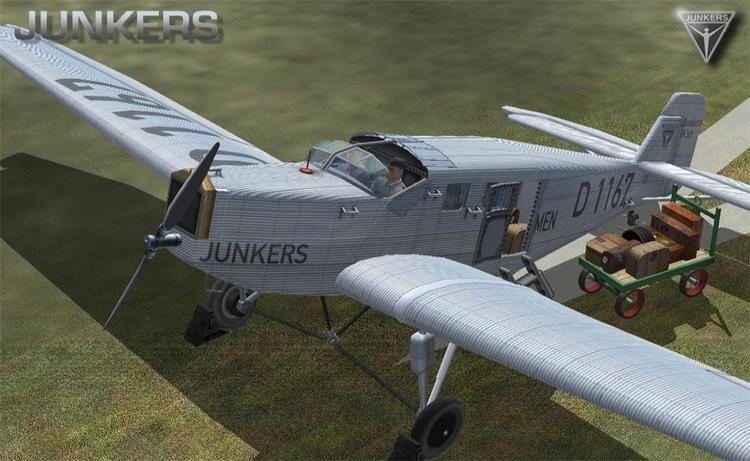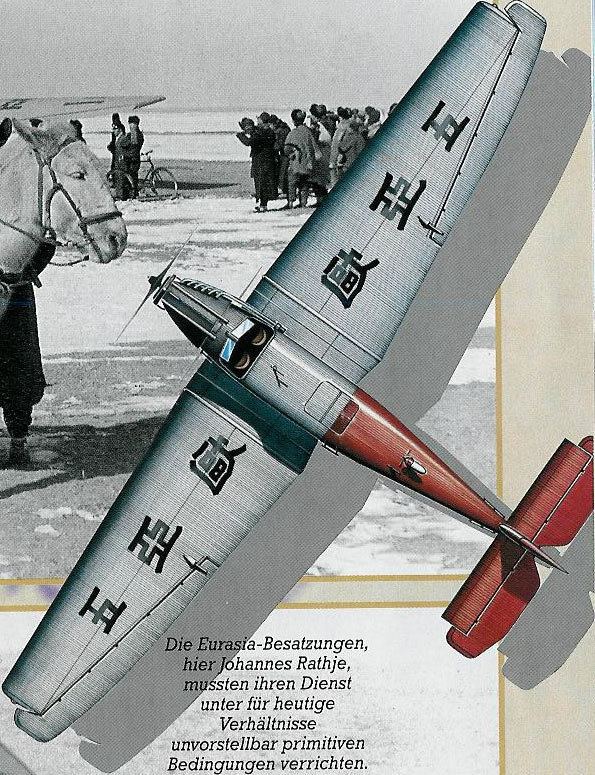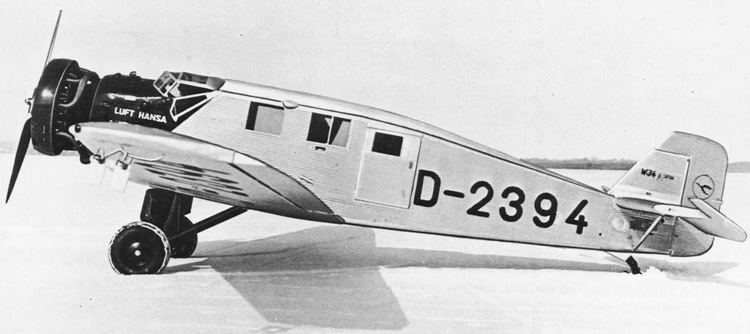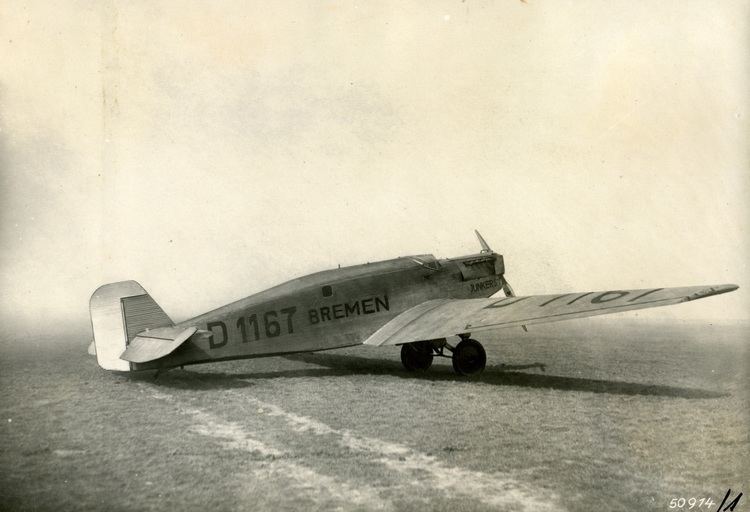Top speed 180 km/h Length 10 m Manufacturer Junkers | Wingspan 18 m First flight June 7, 1926 | |
 | ||
Junkers w 33 bremen first flight westward over the atlantic ocean
The Junkers W 33 was a German single-engine transport aircraft. It was aerodynamically and structurally advanced for its time (1920s), a clean, low-wing all-metal cantilever monoplane. Almost 200 were produced. It is remembered in aviation history for the first east–west non-stop heavier-than-air crossing of the Atlantic.
Contents
- Junkers w 33 bremen first flight westward over the atlantic ocean
- Design and development
- Operational history
- Aeronautical distinctions
- Accidents and incidents
- Variants
- Civil operators
- Military operators
- Specifications Landplane
- References

Design and development

The Junkers W 33 was a transport development of the 1919 four-seat airliner, the Junkers F 13. The latter was a very advanced aircraft when built, an aerodynamically clean all-metal cantilever (without external bracing) monoplane. Even later in the 1920s, it and other Junkers types were unusual as unbraced monoplanes in a biplane age, with only Fokker's designs of comparable modernity. Like all Junkers designs from the J 7 fighter onwards, it used an aluminium alloy duraluminum structure covered with Junkers' characteristic corrugated dural skin. The wings had the same span as the F 13, though the platform was a little different, and the length was the same as the F 13FE. The fuselage, though, was flatter-topped than that of the F 13. A large port-side door gave access to the freight compartment. The 228 kW Junkers L5 upright inline water-cooled engined was also the same as in the F 13FE, though much more powerful than the BMW motors of the F 13A, giving improved weightlifting compared with that early model. The designer of the W 33 was Herman Pohlmann.

The cockpit and undercarriage were of their time, the former enclosed with two seats, and the latter fixed and divided with a tailwheel. The Junkers W letter labelled the type as a seaplane (floatplane), but in practice W 33s flew as both at different times. The prototype W 33, registered D-921, first flew, as a seaplane, from Leopoldshafen on the river Elbe near Dessau on 17 June 1926.

Production began in 1927 and ran until 1934 with 198 production machines built. Most of these were built at the Junkers works at Dessau, but a small number were assembled at Junker's Swedish subsidiary AB Flygindustri at Limhamn near Malmö and in the USSR. The Swedish plant had been set up in the early 1920s to avoid the post-war restrictions on aircraft building, which included civil types during 1921-2. The Russian works at Fili near Moscow was used initially to build the H 21 and H 22 fighters for the Red Army. There were over 30 W 33 variants, so only a few are listed below.
Operational history

The first two W33 prototypes competed very soon after their first flights at the Deutschen Seeflug seaplane competition at Warnemünde in July 1926. The first prototype W 33, D-921, flew as no.7 and came second in the contest. The second prototype, a W 33a, flew as no.8.

W 33s were used by many operators across the world in the late 1920s and 1930s. They served as general transports and specialised mailplanes. Deutsche Luft Hansa had only four, which ran mail from 1929. Others were used as survey aircraft and crop-sprayers. Later, the Luftwaffe used some as trainers.

The Colombian Air Force used Junkers W 33, W 34 and K 43 in the Colombia-Peru War (1932–1933). The Ethiopian Air Force had one W 33c during the Second Italo-Abyssinian War.

One Junkers W 33g was used by the Swedish Air Force from 1933-5 as an air ambulance and known as the transport type Trp2. It is possible that this aircraft was assembled at Linhamm, as were four W 33s bound for Australia. After World War II, this aircraft served in a utility role with the Swedish Air Force squadron F2 flying out of Hägernäs. From there, in June 1952, it participated in the search and rescue operations during the famous Catalina Affair, in which two Soviet MiG-15s engaged and shot down a Swedish intelligence aircraft (a C-47) and then later another SAR aircraft, a PBY Catalina.
Russian-registered W 33s (17 of them, mostly assembled in Russia at Fili from imported parts) were designated PS-4 for Passazhirskii Samolyot (passenger aircraft or airliner). At least 9 Russian-built W 33s appeared on that country's pre-war civil register.
Aeronautical distinctions
The Junkers W 33 set numerous records, and one made the first east-to-west crossing of the Atlantic by airplane. The North Atlantic had been first crossed, non-stop and by a heavier-than-air craft, by Alcock and Brown in 1919 in a Vickers Vimy. They flew west to east, with the prevailing winds from St. John's, Newfoundland, to Clifden, Ireland, in just under 16 hrs. The east-to-west flight was always more challenging, but became feasible as aircraft performance improved through the 1920s. On April 12–13, 1928, W 33 D-1167 Bremen flew from Baldonnel near Dublin in Ireland to Greenly Island, Canada, off Labrador in 37 hours. Strong westerly winds took them north of their intended destination, New York, but they landed safely. The crew were Köhl, von Hünefeld and Fitzmaurice. The aircraft is now on display at Bremen Airport, Germany.
A W 33 set class C world records for both endurance of 52 h 22 m and distance (4661 km or 2896 mi) on one flight at Dessau between 3 and 5 August 1927, piloted by Johann Risztics and Edzard. A little earlier Fritz Loose and W.N. Schnabele had set another Class C record for duration and distance, this time carrying a useful 500 kg load. They stayed aloft for 22 h 11 m and travelled 2736 km (1701 mi). At about the same time, the W33 set a similar pair of records in Class Cbis (Seaplanes).
A W 33 (much modified and sometimes referred to as a W 34) established a world altitude record on 26 May 1929, piloted by Willy Neuenhofen at 41,800 ft (12740 m).
There were failures, too. The first Swedish-assembled W33 was ready by May 1930, and was delivered two months later to Mitsubishi in Japan. This aircraft was used in an attempt in 1932 to fly across the Pacific Ocean to the US, but the attempt failed and the aircraft disappeared. Neither aircraft parts nor any survivors were found, although the search lasted over six months.
Accidents and incidents
Variants
Civil operators
Soviet designation PS-4
Military operators
Specifications (Landplane)
Data from Turner
General characteristics
Performance
